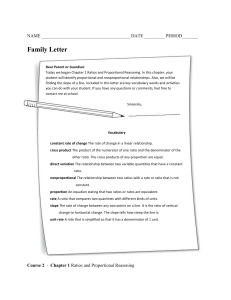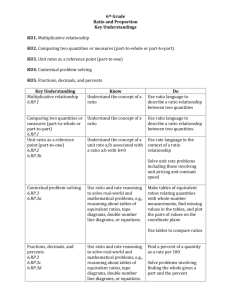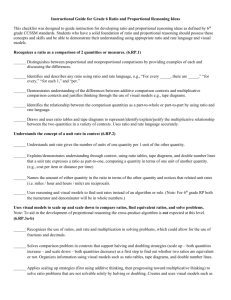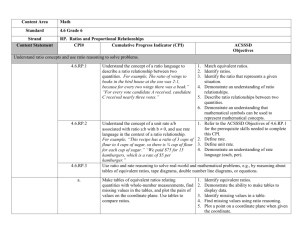Quarter 1 - Monroe County 6
advertisement
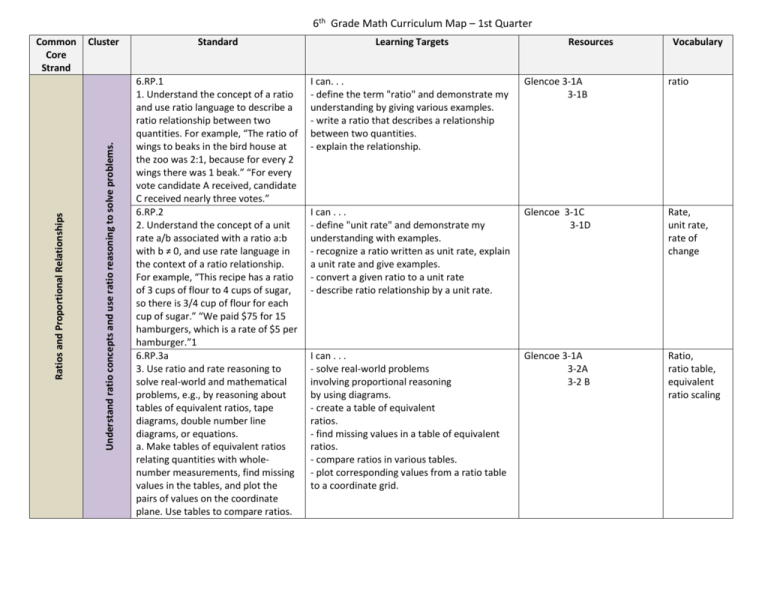
6th Grade Math Curriculum Map – 1st Quarter Cluster Understand ratio concepts and use ratio reasoning to solve problems. Ratios and Proportional Relationships Common Core Strand Standard Learning Targets Resources Vocabulary 6.RP.1 1. Understand the concept of a ratio and use ratio language to describe a ratio relationship between two quantities. For example, “The ratio of wings to beaks in the bird house at the zoo was 2:1, because for every 2 wings there was 1 beak.” “For every vote candidate A received, candidate C received nearly three votes.” 6.RP.2 2. Understand the concept of a unit rate a/b associated with a ratio a:b with b ≠ 0, and use rate language in the context of a ratio relationship. For example, “This recipe has a ratio of 3 cups of flour to 4 cups of sugar, so there is 3/4 cup of flour for each cup of sugar.” “We paid $75 for 15 hamburgers, which is a rate of $5 per hamburger.”1 6.RP.3a 3. Use ratio and rate reasoning to solve real-world and mathematical problems, e.g., by reasoning about tables of equivalent ratios, tape diagrams, double number line diagrams, or equations. a. Make tables of equivalent ratios relating quantities with wholenumber measurements, find missing values in the tables, and plot the pairs of values on the coordinate plane. Use tables to compare ratios. I can. . . - define the term "ratio" and demonstrate my understanding by giving various examples. - write a ratio that describes a relationship between two quantities. - explain the relationship. Glencoe 3-1A 3-1B ratio I can . . . - define "unit rate" and demonstrate my understanding with examples. - recognize a ratio written as unit rate, explain a unit rate and give examples. - convert a given ratio to a unit rate - describe ratio relationship by a unit rate. Glencoe 3-1C 3-1D Rate, unit rate, rate of change I can . . . - solve real-world problems involving proportional reasoning by using diagrams. - create a table of equivalent ratios. - find missing values in a table of equivalent ratios. - compare ratios in various tables. - plot corresponding values from a ratio table to a coordinate grid. Glencoe 3-1A 3-2A 3-2 B Ratio, ratio table, equivalent ratio scaling Understand ratio concepts and use ratio reasoning to solve problems. Ratios and Proportional Relationships 6th Grade Math – 1st Quarter 6.RP.3b 3. Use ratio and rate reasoning to solve real-world and mathematical problems, e.g., by reasoning about tables of equivalent ratios, tape diagrams, double number line diagrams, or equations. b. Solve unit rate problems including those involving unit pricing and constant speed. For example, if it took 7 hours to mow 4 lawns, then at that rate, how many lawns could be mowed in 35 hours? At what rate were lawns being mowed? 6.RP.3c 3. Use ratio and rate reasoning to solve real-world and mathematical problems, e.g., by reasoning about tables of equivalent ratios, tape diagrams, double number line diagrams, or equations. c. Find a percent of a quantity as a rate per 100 (e.g., 30% of a quantity means 30/100 times the quantity); solve problems involving finding the whole, given a part and the percent. I can . . . - use proportional reasoning to solve unit rate problems. Glencoe 3-1C 3-1D 3-2A, B 3-3A, B, C Ratio, equivalent ratios, ratio tables, rate, unit rate, scaling, I can . . . - use visual representation to model percents. (strip diagrams, percent bars, one-hundred grids). - write a percent as a rate per one-hundred. - use proportional reasoning to find the percent of a given number. Glencoe 4-2A, B, C 4-2E 4-4A, B, C, D, E Additional Lesson 2 Percent, Proportion, Percent, proportion Page 2 of 3 Understand ratio concepts and use ratio reasoning to solve problems. Ratios and Proportional Relationships 6th Grade Math – 1st Quarter 6.RP.3d Understand ratio concepts and use ratio reasoning to solve problems. 3. Use ratio and rate reasoning to solve real-world and mathematical problems, e.g., by reasoning about tables of equivalent ratios, tape diagrams, double number line diagrams, or equations. d. Use ratio reasoning to convert measurement units; manipulate and transform units appropriately when multiplying or dividing quantities. I can . . . - use a ratio as a conversion factor when working with measurements of different units. Glencoe Start Smart 5 Additional Lesson 3 unit ratio, dimensional, analysis Page 3 of 3
